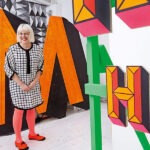
Co-create, Co-design, Co-exist – Collaborations and the Design World.

As globalisation continues to dominate today’s society (even during a pandemic), many industries are bridging into one another, and the creative industry is no exception. It is common to here that a some multi-million franchise has joined forces with a well-known designer for a project. Some examples that come to mind are Disney and Dalì working together on Destino – a animation what was supposed to be released in 1946, Gucci and Fiat, where they designed a limited edition Fiat 500C in 2012 and the collaboration between Tetris and Puma in 2019.

This month is all about collaborations and identifying different methods of how designers worked alongside other professionals from different fields and come up with a solution to any given problem. This week’s lecture was a series of case studies, ranging from publication to spatial design. The designers of the respective project were given the chance to talk about how they went about working on the project from inception to completion. The most striking was probably Myerscough’s murals and wall designs in the children’s hospital, and for obvious reasons. Apart from the fact that the project was one of the broadest out of all the case studies, but also the fact that it involved ‘children in need’ to an extent. People always seem to sympathise with such projects.
Lots of interesting points were brought up in the lecture this week. What I came to realise is that graphic designers are starting to show a big interest in journalism and sociology. With reference to the Migrant publications by Offshore Studio, it seems that such form of publication design is becoming more and more popular. Similarly, back in Module 2, we looked at Richard Mosse’s photo documentation in Congo, where he experimented with infrared lenses to capture an ’alternate reality’ to show a new perspective on conflict. Another example of this is Riposte, a publication started by Danielle Pender, where together with er team, they publish ‘a smart magazine for women’. It was inspired by the female icons of the 90s such as Gwen Stefani and Björk and as a reaction to many tabloid magazine were women are often subject to scrutiny and negative opinions.
Another recurring trait I noticed in this week’s lectures and sources is the introduction, comparison and contrast of a number of terms. Starting off with:
- Playtotyping™: ‘learning through play’. This term is actually trademark by HATO Press, and it is the name given to the workshops they designed to create engagement. Such workshops are used in communities, workplaces and schools. The idea behind this whole project is to make learning and engagement fun for everyone. As people respond differently to their surroundings, sometimes all they need is a little push towards the right direction, then they gain momentum. You can more about it on their website.
- Co-Designing and Co-Creating: Two other terms that were mentioned by HATO Press. They are quite self-explanatory. They were simply describing forms of collaboration between different people, but I liked the ring these two words had.
- Interdisciplinary and Antidisciplinary: These two words were mentioned in an article by Joichi Ito for JoDS, shared by one of the tutors on the Ideas Wall. I was familiar with the term ‘interdisciplinary’ – it is when people from different disciplines work together towards reaching a goal. However, ‘antidisciplinary’ is when there are people working in spaces that do not fit into any existing academic discipline. It is a field of study with its own particular terminology, frameworks and methods.
- Cybernetics: A movement occurring in the 40s and 50s that brought people from different fields of expertise to begin to understand systems and feedback loops to learn to understand and create complex system. Such an example that survived tto this day is design thinking.
- Synthetic Biology: Anther term linked to the previous two. It is the area of study that explores how nature can be mimicked and edited. It seeks to find ways of altering natures true course. The question here is if it is indeed possible, of if nature reigns supreme. Year 2020 seems to be the year where we would debunk this question.
Lastly, I would like to conclude by making a reference to the Designboom’s interview to Vaughan Oliver. In his interview he talks about his numerous projects with musicians and how he ended up designing a lot of record covers over the course of his career. When it comes to giving his opinion on collaboration, he says that collaboration brings out the best in people. To which I agree. In his words, using his clientele as an example, he says:
“Collaboration brings more out of me. I tend to find it also brings more out of the other person. Collaborating with a musician on the artwork for their music is a bit different, that’s a kind of client / designer collaboration process that i’ve always been used to. What i’m referring to here is the collaboration with other artists, illustrators and photographers – it was a great experience sourcing artists to work with the different 4ad bands. I just think it’s nicer to create things together with other people than to do them on your own.”
Vaughn Oliver for Designboom, 2014
A similar view is shared in that article for JoDs. By bringing together design and science, a rigorous yet flexible approach can be created that will allow all stakeholders involved in a project to explore, understand and contribute to science in an ‘antidisciplinary’ way.





